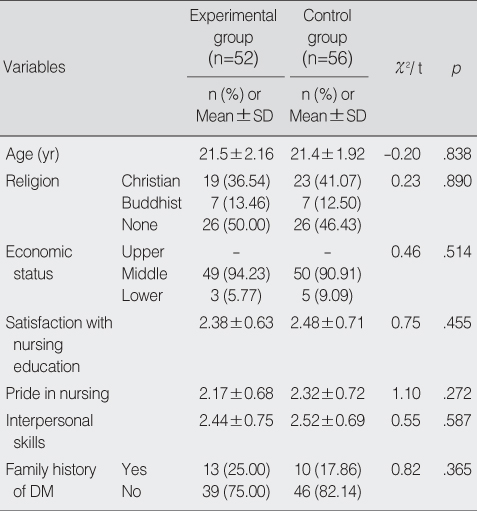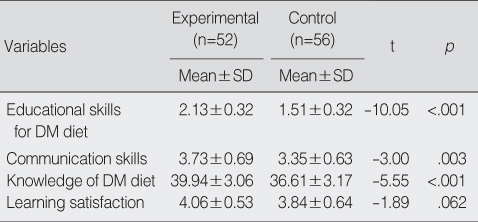Articles
- Page Path
- HOME > J Korean Acad Nurs > Volume 39(2); 2009 > Article
-
Original Article
- Development of a Multimedia Learning DM Diet Education Program using Standardized Patients and Analysis of Its Effects on Clinical Competency and Learning Satisfaction for Nursing Students
- Kyung Sun Hyun, Hyun Sook Kang, Won Ock Kim, Sunhee Park, Jia Lee, Sohyune Sok
-
Journal of Korean Academy of Nursing 2009;39(2):249-258.
DOI: https://doi.org/10.4040/jkan.2009.39.2.249
Published online: April 28, 2009
1Professor, College of Nursing Science, East-West Nursing Research Institute, Kyung Hee University, Seoul, Korea.
2Assistant Professor, College of Nursing Science, East-West Nursing Research Institute, Kyung Hee University, Seoul, Korea.
- Address reprint requests to: Kang, Hyun Sook. College of Nursing Science, Kyung Hee University, 1 Hoegi-dong, Dondaemun-gu, Seoul 130-701, Korea. Tel: 82-2-961-0313, Fax: 82-2-961-9398, hyunsuk@khu.ac.kr
• Received: August 14, 2008 • Accepted: March 18, 2009
Copyright © 2009 Korean Society of Nursing Science
Abstract
-
Purpose
- The purpose of this study was to develop a multimedia learning program for patients with diabetes mellitus (DM) diet education using standardized patients and to examine the effects of the program on educational skills, communication skills, DM diet knowledge and learning satisfaction.
-
Methods
- The study employed a randomized control posttest non-synchronized design. The participants were 108 third year nursing students (52 experimental group, 56 control group) at K university in Seoul, Korea. The experimental group had regular lectures and the multimedia learning program for DM diet education using standardized patients while the control group had regular lectures only. The DM educational skills were measured by trained research assistants.
-
Results
- The students who received the multimedia learning program scored higher for DM diet educational skills, communication skills and DM diet knowledge compared to the control group. Learning satisfaction of the experimental group was higher than the control group, but statistically insignificant.
-
Conclusion
- Clinical competency was improved for students receiving the multimedia learning program for DM diet education using standardized patients, but there was no statistically significant effect on learning satisfaction. In the nursing education system there is a need to develop and apply more multimedia materials for education and to use standardized patients effectively.
- 1. Barrett C, Myrick F. Job satisfaction in preceptorship and its effect on the clinical performance of the preceptee. Journal of Advanced Nursing. 1998;27:364–371.ArticlePubMedPDF
- 2. Barrows HS. An overview of the uses of standardized patients for teaching and evaluating clinical skills. Academic Medicine: Journal of the Association American Medical Collegs. 1993;68:443–451.
- 3. Basco WT Jr, Lancaster CJ, Gilbert GE, Carey ME, Blue AV. Medical school application interview score has limited predictive validity for performance on a fourth year clinical practice examination. Advances in Health Science Education: Theory and Practie. 2008;13:151–162.ArticlePDF
- 4. Bearnson CS, Wiker KM. Human patient simulators: A new face in baccalaureate nursing education at Brigham Young University. The Journal of Nursing Education. 2005;44:421–415.ArticlePubMed
- 5. Bellamy N, Anjema C, Alikhan N, Chhina T, Dhanoa D, Edelist D, et al. An evaluation of the effectiveness of a videotape programme on interobserver reliability in outcome assessment for osteoarthritis. Inflammopharmacology. 1999;7:143–154.ArticlePubMedPDF
- 6. Bennett AJ, Arnold LM, Welge JA. Use of standardized patients during a psychiatry clerkship. Academic Psychiatry. 2006;30:185–190.ArticlePubMed
- 7. Carter MB, Wesley G, Larson GM. Lecture versus standardized patient interaction in the surgical clerkship: A randomized prospective cross-over study. American Journal of Surgery. 2006;191:262–267.ArticlePubMed
- 8. Chipman JG, Beilman GJ, Schmitz CC, Seatter SC. Development and pilot testing of an OSCE for difficult conversations in surgical intensive care. Journal of Surgical Education. 2007;64:79–87.ArticlePubMed
- 9. Cho HS. A study on the critical thinking disposition and clinical competency of nursing students. The Journal of Korean Academic Society of Nursing Education. 2005;11:222–231.
- 10. Choi JY, Jang KS, Choi SH, Hong MS. Validity and reliability of a clinical performance examination using standardized patients. Journal of Korean Academy of Nursing. 2008;38:83–91.ArticlePubMed
- 11. Foley ME, Nespoli G, Conde E. Using standardized patients and standardized physicians to improve patient-care quality: Results of a pilot study. Journal of Continuing Education in Nursing. 1997;28:198–204.ArticlePubMed
- 12. Heine N, Garman K, Wallace P, Bartos R, Richards A. An analysis of standardized patient checklist errors and their effect on student scores. Medical Education. 2003;37:99–104.
- 13. Hwang K, Lee YM, Baik SH. Clinical performance assessment as a model of Korean medical licensure examination. Korean Journal of Medical Education. 2001;13:277–287.Article
- 14. Im H, Kim SS. A study of investigating error sources and reliability for clinical performance examination (CPX). Journal of Education Evaluation. 2005;18:27–46.
- 15. Im Y, Lee O. A study on relations among the learning participation, learning satisfaction and academic achievement of cyber learners. The Journal of Yeolin Education. 2008;16:177–200.
- 16. Iramaneerat C, Yudkowsky R. Rater errors in a clinical skills assessment of medical students. Evaluation & the Health Professions. 2007;30:266–283.ArticlePDF
- 17. Kim HS, Yi YJ, Yang IS. The effects of clinical practice in school on clinical competence in nurse. The Journal of Korean Academic Society of Nursing Education. 2005;11:206–213.
- 18. Kim JJ, Lee KJ, Choi KY, Lee DW. Analysis of the evaluation for clinical performance examination using standardized patients in one medical school. Korean Journal of Medical Education. 2004;16:51–61.Article
- 19. Lee BG. Recent world trend in performance-based assessments and application of the standardized patient program in Korean medical education. Korean Journal of Medical Education. 2000;12:377–392.Article
- 20. Lee JD, Triola M, Gillespie C, Gourevitch MN, Hanley K, Truncali A, et al. Working with patients with alcohol problems: A controlled trial of the impact of a rich media web module on medical student performance. Journal of General Internal Medicine. 2008;23:1006–1009.ArticlePubMedPMCPDF
- 21. McLaughlin K, Gregor L, Jones A, Coderre S. Can standardized patients replace physicians as OSCE examiners? BMC Medical Education. 2006;6:12. PubMedPMC
- 22. Park WB, Lee SA, Kim EA, Gwack J, Yoo KY, Shin JS, et al. Evaluation using simulated students for reliability of multiple standardized-patients scoring in clinical performance examinations. Medical Teacher. 2007;29:978–980.ArticlePubMed
- 23. Reteguiz JA. Relationship between anxiety and standardized patient test performance in the medicine clerkship. Journal of General Internal Medicine. 2006;21:415–418.ArticlePubMedPMC
- 24. Seong KY. Effects of practice nursing education: Using standardized patients on subcutaneous insulin injection. 2008;Daejeon, Eulji University. Unpublished master's thesis.
- 25. Triola M, Feldman H, Kalet AL, Zabar S, Kachur EK, Gillespie C, et al. A randomized trial of teaching clinical skills using virtual and live standardized patients. Journal of General Internal Medicine. 2006;21:424–429.ArticlePMC
- 26. Wang WD, Yang PC, Chen CY, Lue BH, Yang PM. Using senior residents as standardized patients for evaluating basic clinical skills of medical students. Journal of the Formosan Medical Association. 2004;103:519–525.PubMed
- 27. Wolman BB. Dictionary of behavioral science. 1989;2nd ed. San Diego, CA, Academic Press.
- 28. Yang JJ. Effects of web-based multimedia contents for mechanical ventilator practice on knowledge and clinical competence of nursing students. Journal of Korean Academy of Adult Nursing. 2006;18:231–239.
- 29. Yi YJ, Lim NY, Lee EH, Han HJ, Kim JH, Son HM, et al. Evaluation on the practicum using standardized patients for nursing assessment to articular disease. Journal of Muscle and Joint Health. 2007;14:137–148.
- 30. Yoo MS. Development of standardized patient managed instruction for a Fundamentals of Nursing course. 2000;Seoul, Yonsei University. Unpublished doctoral dissertation.
- 31. Yoo MS, Yoo IY, Park YO, Son YJ. Comparison of student's clinical competency in different instructional methods for Fundamentals of Nursing practicum. Journal of Korean Academy of Nursing. 2002;32:327–335.
REFERENCES
Figure & Data
REFERENCES
Citations
Citations to this article as recorded by 

- The Effects of Mobile Learning and Group Discussion for Psychotropic Drug Education on Nursing Students’ Learning, Satisfaction, and Attitude: An Educational Intervention
Manoosh Mehrabi, Zahra Tabandeh, Ladan Zarshenas, Ali Akbar Nekooeian, Ebrahim Moghimi Sarani
Shiraz E-Medical Journal.2024;[Epub] CrossRef - The development and effects of a nursing education program for hyperglycemia patient care using standardized patients for nursing students
Jin Lee, Pok Ja Oh
The Journal of Korean Academic Society of Nursing Education.2023; 29(4): 427. CrossRef - Experience of nursing students with standardized patients in simulation-based learning: Q-methodology study
Eun-Ho Ha
Nurse Education Today.2018; 66: 123. CrossRef - Utilizing Video vs Simulation Practice for Handoff Education of Nursing Students in Pediatric Nursing
Sun-Nam Park, Young Soon Im
Child Health Nursing Research.2018; 24(1): 27. CrossRef - Effectiveness of Education Program Using Video Recording and Feedback on Skill Competency for Students of Majors in Health Care: A Meta-Analysis
Yun Hee Shin, Sun Kyung Kim, Hyunjoo Kim
Journal of Korean Academy of Fundamentals of Nursing.2018; 25(2): 120. CrossRef - Reliability and Validity of the Assessment Tool for Measuring Communication Skills in Nursing Simulation Education
Hee Mo Yang, Seon Young Hwang
Korean Journal of Adult Nursing.2016; 28(1): 95. CrossRef - The Effects of Preclinical Clinical Performance Examination on Nursing Students' Confidence in Nursing Skills and Critical Thinking Competence
Jeong Sook Park, Mi Jung Choi, Soon Yang Jang
The Journal of Korean Academic Society of Nursing Education.2015; 21(1): 75. CrossRef - The effects of simulation-based learning using standardized patients in nursing students: A meta-analysis
Pok-Ja Oh, Kyeong Deok Jeon, Myung Suk Koh
Nurse Education Today.2015; 35(5): e6. CrossRef - Approaches to Convergence Curriculum for Healthcare-Affiliated Students with Clinical Competence Assessment Program
Eun-Hee Park, Hae-Ryoung Park, Hye-Suk Kim
Journal of the Korea Convergence Society.2015; 6(3): 79. CrossRef - The effect of Simulation-based learning scenario using standardized repiratory patients on learning satisfaction, clinical skill competency and self-efficacy in Health-related department students
Hye-Young Cho
Journal of the Korea Academia-Industrial cooperation Society.2015; 16(3): 2100. CrossRef - Development and evaluation of simulation-based fever management module for children with febrile convulsion
Shin-Jeong Kim, Jina Oh, Kyung-Ah Kang, SungHee Kim
Nurse Education Today.2014; 34(6): 1005. CrossRef - Systematic Review of Korean Studies on Simulation within Nursing Education
Jung-Hee Kim, In-Hee Park, Sujin Shin
The Journal of Korean Academic Society of Nursing Education.2013; 19(3): 307. CrossRef - The Effects of Simulation Training With Hybrid Model for Nursing Students on Nursing Performance Ability and Self Confidence
Suk Jeong Lee, Young Mi Park, Sang Mi Noh
Korean Journal of Adult Nursing.2013; 25(2): 170. CrossRef - The effects of two educational interventions on knowledge and competence of nurses with regard to conveying gastroscopy‐related information to patients
Shu‐Hua Kao, Li‐Ling Hsu, Suh‐Ing Hsieh, Tzu‐Hsin Huang
Journal of Advanced Nursing.2013; 69(4): 793. CrossRef - Effects of using Standardized Patients on Nursing Competence, Communication Skills, and Learning Satisfaction in Health Assessment
Sun Ju Choi, Mal Suk Kwon, Seon Hwa Kim, Hyeon Mi Kim, Yang Sook Jung, Geum Yi Jo
The Journal of Korean Academic Society of Nursing Education.2013; 19(1): 97. CrossRef - Effect of a Suction Care Education Program on Undergraduate Nursing Students
Hyun-Ju Kim, So-Young Kang
Journal of the Korea Academia-Industrial cooperation Society.2013; 14(3): 1197. CrossRef - Comparison of Multi-Mode Simulation and SimMan(R)Simulation on Evaluation of Nursing Care for Patients with Dyspnea
Suk-Jeong Lee, Young-Sook Roh, Ju-Ok Kim, Kie-In Jang, Eon-Na Ryoo, Young-Mi Park
The Journal of Korean Academic Society of Nursing Education.2010; 16(1): 51. CrossRef
Development of a Multimedia Learning DM Diet Education Program using Standardized Patients and Analysis of Its Effects on Clinical Competency and Learning Satisfaction for Nursing Students

Figure 1
Research process.
Figure 1
Development of a Multimedia Learning DM Diet Education Program using Standardized Patients and Analysis of Its Effects on Clinical Competency and Learning Satisfaction for Nursing Students
General Characteristics and Homogeneity between the Experimental and Control Group
DM=diabetes mellitus.
Mean Differences of the Outcome Variables between the Experimental and Control Group
DM=diabetes mellitus.
Table 1
General Characteristics and Homogeneity between the Experimental and Control Group
DM=diabetes mellitus.
Table 2
Mean Differences of the Outcome Variables between the Experimental and Control Group
DM=diabetes mellitus.
 KSNS
KSNS
 E-SUBMISSION
E-SUBMISSION



 Cite
Cite

